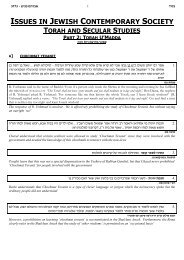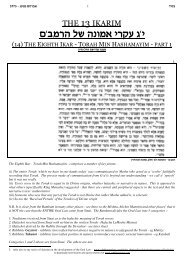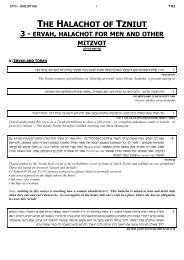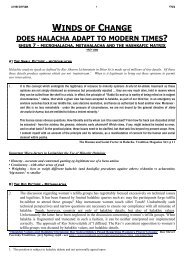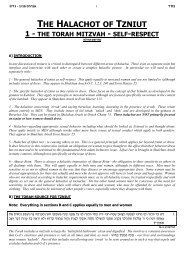You also want an ePaper? Increase the reach of your titles
YUMPU automatically turns print PDFs into web optimized ePapers that Google loves.
dbhbn ovrct<br />
1<br />
sxc<br />
ISSUES IN JEWISH CONTEMPORARY<br />
SOCIETY<br />
BAT MITZVAH<br />
vhju kjr ,arsn rbnx<br />
vrag vbuna ic /sunk,k vrag anj ic /,umnk vrag aka ic /vbank rag ic /trenk ohba anj ic rnut vhv tuv 1.<br />
ic /vchak ohgca ic /vbezk ohaa ic /vmgk ohanj ic /vbhck ohgcrt ic /jfk ohaka ic /;usrk ohrag ic /vpujk<br />
:okugv in kycu rcgu ,n ukhtf vtn ic /juak ohga, ic /vrucdk ohbuna<br />
tf vban v erp ,uct ,fxn vban<br />
The Mishna in Avot records various life stages of ‘coming of age’. One of them is 13 for mitzvot i.e. the age at which a<br />
boy become obligated to keep mitzvot min haTorah<br />
dh ic tuva sg aht hure ubhtu'ostv ,tyj kfn uagh hf vat ut aht (u:v rcsnc) ch,fs - ,umnk vrag aka ic 2.<br />
'vba rag vaka ic huk vhv ztu 'ucrj aht vbhs hjt huku iugna cegh hbc hba ujehu (s"k ,hatrc) o,v ijfatsfu<br />
kt ,hcc cegh vaga ohba c cuaj,af<br />
oa har<br />
Rashi there explains that the age for liability in mitzvot is defined by the passuk as when a person becomes an ‘ish’. The<br />
fixing of this as 13 is learned from the episode of Shimon and Levi in Shechem (Br. 34). Levi is described there as an<br />
‘ish’ and is thirteen years old<br />
3.<br />
oa har<br />
Another interpretation: a thirteen year old boy is liable in mitzvot because whoever has grown two pubic hairs is obligated by the<br />
Torah in mitzvot as a ‘halacha leMoshe miSinai’ and Chazal estimated that two hairs appear at the age of 13. Therefore we enter<br />
him into the mitzvot from that time on, on the assumption that he has grown two hairs, just as we find in the majority of children.<br />
But in a case where we know with certainty that he has not yet grown two hairs. he does not have any obligation in mitzvot min<br />
haTorah at 13 but only a rabbinic obligation to be educated<br />
Rashi goes on to give another explanation - that the actual age for obligation in mitzvot was transmitted orally to Moshe<br />
on Sinai as the age at which the child grows two pubic hairs. Chazal established this as 13 for boys on the basis of the<br />
halachic principal of ‘rov’ - that we follow the majority. If, however, we know for a fact that the boy does not have the<br />
hairs, he is not a ‘gadol’ in halacha and is not obligated in mitzvot min haTorah.<br />
kkfc tuvu 'tuv hbhxn vank vfkv hf 'gs tk ifn ,ujp kct 'ihabug rc tuv sjt ouhu vba d"h ics ubk ihtn :,ktaau 4.<br />
vp kgc vank i,b rcs kfk vcmeu rughas `hbhxn vank vfkv iva 'ihmhjnu ihmhmj ihrugha<br />
t inhx zy kkf a"trv ,"ua<br />
The Rosh (Germany/Spain - 1250-1327) explains that the age of bar mitzvah is like all ‘shiurim’ e.g. kezayit which were<br />
given on Sinai as part of the Oral Torah<br />
ihgsuh urnta p"gt 'vzv inzk osue /// ihnhhe uhrsb sjt ouhu vba d"h ic/// 'ihnhhe vhrsb - wt ouhu vba vrag oh,a ,c /// 5.<br />
(iv ohbyes - h"ar) ///rsb ovhrsb iht /// ubrsb hn oak ubt<br />
:vn vsb<br />
The Mishna elsewhere puts the age of majority for boys at 13 and for girls at 12
dbhbn ovrct<br />
2<br />
sxc<br />
o¨sẗ¨vk¤t ¨v¤tc±h³u v¨¦tk o¨sẗ¨vi¦n j©ekr¤J£t gkM©v,¤t oheO¡t «v ic°H³u 6.<br />
cf:c ,hatrc<br />
When Hashem made the first woman the Torah uses the word ‘vayiven’ - literally that He built Chava out of Adam’s side<br />
/ahtcn r,uh vatc vrh,h vbhc v"cev i,ba snkn /gkmv ,t ohekt wv ichu ch,fs hcrs y"n :tsxj r"t /hcr hrcs ukt 7.<br />
:vn vsb<br />
The Gemara to the Mishna referred to in (5) above explains that Hashem made women with a higher level of ‘bina’ -<br />
understanding - than men.<br />
ihcvk ,rvnna aurhp vrh,h vbhc 8.<br />
oa t"cyhrv haushj<br />
The Ritva (Spain 14C) explains that this means that girls mature earlier than boys, hence their bat mitzvah at 12, but not<br />
that women are more intelligent than men<br />
/t,hhruts ihrugha kff uvbhb t,fkhv hbv kf ch ,cu t"h ,cu wd ,c vatcu 9.<br />
tb inhx k"hrvn ,"ua<br />
The Maharil (Germany 14C) confirms that the bat mitzvah age of 12 is also ‘halacha leMoshe miSinai’<br />
tk tvs 'ibcrk tcy tnuh tbshcg ',umnv in ruyp tnux :rnts 'h"rf vfkv hk rnt vuvs itn 't"v ahrn :;xuh cr rnt 10.<br />
itn 'vcrst 'vaugu vuumn ubhta hnn r,uh vaugu vuumn kusd :tbhbj r"ts tvk t,hgnas t,av 'tbshcg tvu tbshephn<br />
ibcrk tcy tnuh tbshcg 'vsuvh hcrf vfkv ihts hk rnts<br />
/tk ihaushe<br />
Rav Yosef said: Originally, I thought that if anyone could show me that the halacha was like <strong>Rabbi</strong> Yehudah - who says that a blind<br />
person is exempt from mitzvot - I would make a festive meal for the <strong>Rabbi</strong>s [to celebrate] because I would not then be obligated to<br />
do mitzvot, yet I do them anyway! Now that I have heard the teaching of <strong>Rabbi</strong> Chanina - that one who is obligated in mitzvot and<br />
does them is greater than one was does them even though exempt - on the contrary! If anyone can show me that the halacha is not<br />
like <strong>Rabbi</strong> Yehudah I would make a festive meal for the <strong>Rabbi</strong>s!!<br />
Rav Yosef was blind and he knew that <strong>Rabbi</strong> Yehuda’s opinion was that a blind person is exempt from all mitzvot. He<br />
was extremely pleased and wanted to make a celebration if this was indeed the halacha since he was therefore exempt<br />
and yet he kept mitzvot anyway. He felt that this was a much higher level - to volunteer to do mitzvot. Then he learnt<br />
that, in fact, the highest reward goes to the person who is obligated to keep mitzvot and also keeps them. Now he does<br />
not want to be exempt and is prepared to make a celebration for anyone who can show him that he, as a blind man, is in<br />
fact obligated in all mitzvot.<br />
/utruc ,umn ohheku urmh kyck shn, dtus tuva hbpn whp - vaugu vuumnv kusd 11.<br />
t sung d ;s vrz vsucg ,fxn ,upxu,<br />
Tosafot explain that the person who is commanded by G-d to do something has a greater yetzer hara to refuse and thus<br />
gets a greater reward for overcoming that feeling<br />
ohb,ubu 'vjna ohaugu /vhkg jhfuh vnau 'uzn vkusd vumn ,sugx lk iht vrutfk 'ohzbfatv ohauga vumn rc ,sugxu<br />
vru,v ,hrcc uxhbfvk 'v,g sg uksda vfz ctvu 'vaugu vumnv kusdu 'vumn rc ,uhvk rgbv vfza 'vhsuvu jca ouenk<br />
itn 'wuf vaugu vumnv kusd tbhbj wr rnts t,av ';uxck ;xuh cr rnta (/tk) ihauses e"px thsvk vhtru /vkkfc<br />
tkt /chhj rcf vhva p"gt /ibcrk tcy tnuh tbshcg ',umnv in ruyp tnux rnts 'tsuvh wrf vfkv ihta hk rnts<br />
y"h ,uagk hutra 'inzvu ,gv ,gdv kg a"f /y"h ,uagk vmr v,g sg uk gsub vhv tka vruact<br />
zk inhx z erp tne tcc vnka ka oh<br />
As for the Bar <strong>Mitzvah</strong> meal which Ashkenazim make, it seems that there is no greater seudat mitzvah than this! We make a<br />
celebration and give praise and thanks to G-d that the boy has merited to become a bar mitzvah - for the person who is obligated<br />
and does mitzvot is greater [than the person who is not]. Also that the father has merited to raise him to this point and bring him<br />
into the covenant of Torah. There is a direct proof to this from Rav Yosef ... Even though he was already obligated in mitzvot, the<br />
mere fact that he was informed about this when he did not realise it previously lead him to make a celebration. All the more so for a<br />
coming of age [when the boy actually becomes obligated], he should make a celebration.<br />
12.
dbhbn ovrct<br />
3<br />
sxc<br />
ubhhvs gnanu vpujk xbfba ouhf vumn rc ubc uagba ouhc vsugx ,uagk ostv kg vumna y"f whx ohyuehkc j"hc wf 13.<br />
:ouh u,utc ubht whpt vumn ,sugx huv arus rgbv ots wf e"cs z"p a"ahcu s"h ,bak xbfba ouhc<br />
s e"x vfr inhx ovrct idn<br />
The Magen Avraham (Poland 17C) paskens that it is a mitzvah for the father to make a Bar <strong>Mitzvah</strong> seuda just like it is a<br />
mitzvah to make a wedding meal. This mitzvah applies on the day that the boy turns 13. If the boy gives a derasha at the<br />
meal, it is considered a seudat mitzvah, even if not on the actual birthday<br />
,hagb hrv 'ivc ,chhj vatva ,umnv kfc ,chhj,nu 'sjt ouhu vba vrag oh,a vk utkna vrgbk oda vtrb vz hpku 14.<br />
ihc kscv kf iht ,tzv vbhjcvna iuhf 'vjnau vtsuv ,sugxc ,umnk v,xhbf ,t dujk hutru ',umn i,utc vaugu vuumn<br />
hp kg ;ta '(zh ,ut vtr ,arp) hj aht ic rpxc kccn ohhj ;xuh hcr iutdv c,f vzc tmuhfu /,umn cuhjk oghdvc 'vrgbk rgb<br />
kg ouhv u,utc vjna vhv,u ,ca hsdc ack,a hutr ouen kfn ',umnk vxbfv ouhc vrgbk vsugx ,uagk udvb tka<br />
vumn rc rgbk ohauga unf vsugxu vchxn vk ,uagk ohdvub ota uhrcsn vtrbu /f"g /,umnv kugk xbfvk v,fza<br />
/vumn vsugxk cajbu 'iudvu hutr rcsv ',umnk ughdvc<br />
,fxnc :vcua, v"s yf inhx c ekj ,gs vuujh ,"ua<br />
Accordingly, it appears that a girl too, who becomes 12 and is obligated in all mitzvot that women are obligated in, becomes a<br />
person who [now] performs mitzvot as one who is commanded. It is therefore fitting to celebrate her entry into mitzvot with a meal<br />
of thanks and joy and in such matters there is no distinction between boys and girls when they come of age. The Gaon Rav Yosef<br />
Chayim writes to this effect in his book ‘Ben Ish Chai’ that even though there was no minhag to make a meal for a girl at bat<br />
mitzvah, nevertheless she should dress in her Shabbat clothes and be happy on that day that she merited to come of age in mitzvot.<br />
It appears from his words that if there were to be a minhag to make a celebration and a meal [for a girl] just as is made for a boy<br />
when he reaches bar mitzvah, such a thing would be entirely proper and the meal would be considered a seudat mitzvah<br />
Rav Ovadia Yosef rules that there is no reason in principle to make a distinction between genders for bar/bat mitzvah<br />
v,gna tcuy rfhba ick s"ku v,ubyen r,uh vkusd ,hagba vnc vagnk ,cc eukj rfhb ihts ouan s"gk iufbvu 15.<br />
;t vjnau vsugx ihaug iht vagnk rfhb tkaf tnkgc vghsh kgu /vaka ihbnu vrag ihbn hgca rcs kfk u,ut ihprmn<br />
ann vjnav v,ut vzc ah omgca<br />
zm inhx c j"ut ekj van ,urdt ,"ua<br />
The correct approach in my view is that there is no noticeable practical difference between the girl now she is over bat mitzvah than<br />
when she was a child. This is not the same as with a boy where [the difference] is very marked in that we now join him into anything<br />
that needs minyan of 10 or 3. For a mere awareness [of difference with a girl] with no noticeable practical difference, we do not<br />
make a meal or a celebration, even though for her personally there is great joy.<br />
Rav Moshe Feinstein disagrees. Given that there is almost no outward change in the role of a girl pre- or post- bat<br />
mitzvah (as opposed to a boy who now counts to a minyan) there is no reason to make a public celebration of a bat<br />
mitzvah<br />
vru, sunk,n vruypa vkgn tfhk aurs, ot ;ts ///<br />
Even if she gives a public dvar Torah, there is no particular merit in this since she is exempt from learning Torah<br />
16.<br />
oa<br />
;t iput ouac ,xbfv ,hcc vz ,uagk iht vbv 'vumn ,ubc uagbaf ,ubcc vjnau rsx vzht dhvbvk ohmpjv ihbg rcsc<br />
htsu tuv vumn ,c ka qxeyq ghbtngrgmvu 'htb, kg ubcbc ;t ,uarv hrcs ,uagk ouen ubht ,xbfv ,hcc hf 'vkhkc tk<br />
rgnrtpgrvn tc ruenva vzc a"fu /,xbfv ,hcc vz ,uagk rh,vk ouen oua ihtu tnkgc kcvu ,uar hrcs er<br />
ihbg oua vz iht kct htar u,hcc vjna vzht ,uagk ctv vmur ot eru /qohchyurxbueu ohnruprvnq rguuhytuurgxbteu<br />
kycn h,hhv hkhj rahht htu /tnkgc ,skuv ouh ka vjnaf er tuv hf 'vumn ,sugxu vumn rcs vz chajvk lnxu<br />
tk ;t vumn rcv ,t tk ;tu ,umnku vru,k ucrek aht oua vz thcv tk gushfa ohbcv ka vumn rcv rsx od ub,bhsnc<br />
ruenn vz tc odu vpc dvbuv rcfa vn p"fg /ohruxht sugu ,ca kukjk vz thcn ,unuen vcrvc vcrstu ',jt vgak<br />
'ruxht tfhka ;t gubnk cuy r,uh whv htsu ,hcc ;t 'kkf vumn ruen tkc tuva ,ubcc vz asjk kct 'kyck vae vumn<br />
/ruxt ihkkp,n ihta vgac vkhkc ;t b"fvhcc ,uagk kct<br />
17.<br />
se inhx t j"ut ekj van ,urdt ,"ua<br />
When it comes to the issue of making a celebration for girls who are bat mitzvah, one must not under any circumstances make this<br />
in a shul, even at night. A shul is not a place to hold an event which is not a mitzvah ... and the bat mitzvah ceremony is certainly a<br />
non-mitzvah is and [in fact] mere nonsense without any halachic source to permit this in a shul.
dbhbn ovrct<br />
4<br />
sxc<br />
This is all the more true when the actual source is from the Reform and Conservative. If the father wishes to make a party at home<br />
he may do so but there is no suggestion that this could be considered a seudat mitzvah; it is merely a birthday party. Indeed if I had<br />
the power to do so I would also abolish the Bar <strong>Mitzvah</strong> for boys, which, as is well known, does not bring anyone closer to Torah and<br />
mitzvot, not even the Bar <strong>Mitzvah</strong> boy and not even temporarily. On the contrary, in many places it simply leads to chilul Shabbat<br />
and other issurim. Nevertheless, since there is already a fixed minhag [for bar mitzvah] which has a Torah source, it is difficult to<br />
abolish. But we should not innovate this for girls without any Torah source at all; and even in the house it would certainly be better<br />
to stop it, although there is no issur. But to do it in shul, even at night at a time other than davening, is prohibited.<br />
Rav Moshe is clearly concerned that the motivation for <strong>Bat</strong> <strong>Mitzvah</strong> is coming from a negative place, with its roots in<br />
Reform. He is also convinced that Bar and <strong>Bat</strong> mitzvah served no constructive religious purposes and even caused<br />
serious aveira. Note that this teshuva was written in America in 1957<br />
t,hhruts hrhxht vnf sug//// ,urgbk ,urdcv ,dhdj dujk ,uku,cu ohrujc ,ohabu ohabt ,ukve khvevk ohmura vnc<br />
vgcac vz kg ubrvzv rcfu 'rgnrtpgrv ktrah hgarku oufgk ,uns,vk u,uuf if vaugv kf htsuca hrjt 'vzc tfht<br />
,ubak vagh tk ifu 'ouhv h,kc vgna ubgna tk rat asj rcs ie,k a"fu /////// ovh,eujc lkhk tka 'gn hbau ,k<br />
ovh,uejcu ouan z"gs trzhct - sutn runj urxht rat vzv rcsc a"f /ruxht subsb ihta rcsc ukhpt ubh,uct hdvbnn<br />
kscunu rurtu xhkuernk ict eruzf tuv hrv vc ehzjnu trnn iez tuv vzv rh,nva htsu /,uhrgs trzhct odu 'ufk, tk<br />
wv ,sgn tvh<br />
(1932) u x jut t iurvt iez ,"ua<br />
It is forbidden to arrange gatherings of men and women, young and old, to celebrate a daughter’s reaching maturity ... because of<br />
several Torah prohibitions. Certainly anyone who arranges such a gathering is imitating non-Jews and non-religious Jews, and the<br />
Torah has warned us against following non-Jewish practices with 7 prohibitions and 2 positive mitzvot. ... All the more so when it<br />
comes to introducing a new practice which we have never heard of before. We must not deviate from our fathers’ customs even<br />
when no shadow of a transgression is involved and certainly not when grave prohibitions are involved - aspects of idolatry due to<br />
[the mitzvah of] ‘not following their practices’ and of immorality. Surely, anyone who permits this is ‘rebellious elder’ and someone<br />
who supports it is like one who ‘throws a stone to merculis’ - he should be cursed and excluded from the congregation of G-d!<br />
u x jut t iurvt iez ,"ua<br />
Rav Aharon Walkin (Pinsk early 20C) is totally opposed to bat mitzvah celebrations on a few grounds including (i) the<br />
halachic issur of chukat hagoy and (ii) the policy issue of innovating new minhagim in Judaism<br />
18.<br />
uz iht ,ntc kct /vz dvbn udvb tka 'ohnsuev ,urusv dvbn sdb tuva ouan 'vumn ,cv ,dhdj ka r,hvv sdb ohbguy ah<br />
rhutv odu 'ohna ,trhu vru, tkn whv ktrahn sjt kfa hpk ',ubcv lubhjc euxgk ufrymv tk ubhbpka ,urusc hf 'vbgy<br />
icrec ,usvhv jur ,t upta ktrah ,hcc uksda ,ubcvu ',usvhv jurcu jhrc tkunnu tkn whv ktrahn rhgu rhg kfc<br />
/ivh,unt hsan ,usvhv ,t uebha ygnfu vagn xptc<br />
h,cc ,ufbj,n ,ubcvu ',usvh ka ehz kf vrgbu rgb kf ckn ,reug cujrv ,gpav /oumg hubha ,urusv ub,ab uhafg kct<br />
ka asuev hdvbnku ktrah ,ru,k vcvt ovhshnk, ckc ahravk ohseua obhta 'ohbukhj rpx h,cc ut ohrfb rpx<br />
/,ubcv ka ifubhjc ubh,ujf kf zfrk ubhkg kyun uhafg 'vnhkav ,usvhv<br />
ukhtu 'ohbck unf ,ubck ohdtus jurvu gcyv hgsnu ,hbukhj ,urpxu ,upa hsunhk 'hkkfv lubhjca 'ck chtfn rcs vz hrvu<br />
ubratk /hrndk ohjhbzn 'ivc ,uchhj ohabva ,uhagn ,uumnk lubhju 'k"zj ka rxunv ,urpxu l"b, hsunhk 'h,sv lubhjc<br />
,ar ,nev /ktrah ,ubc sgc h,s euzhju vru, ka ,usxun ube,u ,tzv vkekev kg osuev rusc ktrah hkusd usng<br />
/ubrus ka r,uhc vrsvbv vbdpvv thv cegh ,hc ka vphenu vkusd<br />
ihc ohauga uz whkpvu ',umnv cuhjk v,gdv ,t ,ck od dujk 'ygnf 'chhjn hdudspv iurehgv ,cuju rahv iuhdvv ,ruau<br />
iuhfzc v,fz rcf ohrjt ohjyac rat ',rducv ,cv ka haubtv adrc vae ,gdup ,urdcv ,dhdjk gdubc ,ubcvu ohbcv<br />
/kufhcf 'thmphmbntv<br />
'u"k whx ws j"ut van ,urdt urpxc ihhyabhp n"r iutdv ,gsk hbt ohfxn n"n 'vumn ,c ,dhdj rh,vk hbt vyuba ;tu<br />
htb,cu /b"fvhck lunxv okutc ut hyrp ,hcc ot hf 'ohabt oa ihta ;t vkhkc tk ;tu b"fvcc uz vdhdj dudjk ihta<br />
vbhca ohrcsc ,uhrehgv ,uumnv vtkvu ouhvn ,rnua ,uhvk vrhvzvku vphktn vars ,rducv ,cv hbpc aursh crva<br />
',uumn ,rhnacu vru, sunhkc kgck euzhjvu sushgv ,cuju 'ohbcv lubhjc kuphyv (vjpan ,rvy ',ca ',uraf) ouenk<br />
,yha hpk ukhpt uz vdhdj rh,vk ohkusd ohngy ov vktv ohrcsv kfu /a"rhu j", tuva ahtc whbhg ,,k vsuea v,uhvu<br />
///// vkt ohbhbgc sutn rhnjn uvbva 't"rdv<br />
oak vkhkj ut vumn oak ohbuuf,n ov ot 'vumn ,cv ,dhdj ka vz dvbn asjk ohmurv ,buufc huk, rcsv vagnku ///<br />
/ohbhnv huehj<br />
ohkuehak ohh,s ohdvbn ka ,uktac ck ohna obhta 'ohrhnjnu ohrxut ohtrhv ihc aha 'hbnn okgb tk obnt<br />
,ruxnc ecsv hsuvhv ckvu /sckc ckv ,uadr h"pg ivhkg ohbs tkt 'ohh,ufkv ohrurhck o,gs ohb,ub obht ;tu 'ohhbuhdv<br />
/// h,sv dvubc tuva hubha kfn g,rb 'ohrunu ohruv<br />
lubhjv euzhjk vsrjc epus ock 'vumn ,c ,dhdj ka vz asj dvbn ka r,hvc ohssmnv od hf jufak ovk iht okut<br />
/,umnv khdk ighdvc hrxun sushgku hbjur iuxhjk r,uhc ,ueuez iv vzv rusc ohhjv ka ,uchxbca 'ktrah ,ubc ka h,sv<br />
19.<br />
(dm:d - iah xupsc) yk inhx c ekj at hshra ,"ua
dbhbn ovrct<br />
5<br />
There are those who argue against permitting bat mitzvah celebrations because they deviate from the practice of previous<br />
generations who never did such things. But, in truth, this is not an argument, for in previous generations there was not a need to be<br />
involved with the education of girls because every Jew was full of Torah and the fear of Heaven and the atmosphere of every Jewish<br />
town was filled with the fragrance and spirit of Judaism. Girls who grew up in a Jewish home absorbed into themselves this spirit of<br />
Judaism without any active steps, almost as if they took it in with their mother’s milk.<br />
But now things have changed greatly. The influence of the street has uprooted any attachment to Judaism from the hearts of young<br />
people. Girls are educated in non-Jewish or non-religious schools which make no effort to implant within the hearts of their students<br />
a love of Torah and the holy practices of authentic Judaism. Now we must therefore focus our energies on girls’ education.<br />
It pains the heart that in secular education, the study of languages, literature and the natural and social sciences are as<br />
conscientiously taught to girls as to boys. But in religious education - the study of Tanach, the ethical teachings of Chazal and in<br />
practical training in those mitzvot which women are obligated to carry out, we abandon them entirely. Fortunately, the leaders of<br />
the Jewish people rose to deal with his major problem in the last generation and set up religious education institutions to teach<br />
Torah and give support to Jewish girls. The establishment of the Beit Ya’acov school network is one of the greatest achievements of<br />
our generation.<br />
Clear logic and the principles of education virtually require equal celebration for a girl when she reaches the age of responsibility for<br />
mitzvot. The difference which is made in the celebration for a boy and a girl upon attaining maturity makes a very hurtful<br />
impression on the feelings of a maturing girl, who in all other area has attained equality.<br />
But although I am inclined to permit the celebration of a bat mitzvah, nevertheless I agree with the view of Rav Moshe Feinstein that<br />
the celebration should not be in a shul, even at night and even when there are no men there, but rather in a private house or the<br />
shul hall. Also, the Rav should give a derasha in front of the girl enjoining her to keep from now on the mitzvot such as kashrut,<br />
Shabbat and family purity, to raise and educate her children, to encourage and support her husband in learning Torah and keeping<br />
mitzvot and to make sure to look to marry a man who is a talmid chacham and yorei shamayim. All of these issues constitute strong<br />
reasons to permit the celebration of a bat mitzvah, even according to the halachic opinion of the Vilna Gaon, who is is very strict in<br />
such matters.<br />
In practice, the matter depends on the motivation and intentions of those people who wish to innovate new customs such as the bat<br />
mitzvah celebration. Are their intentions leshem shamayim or, G-d forbid, just to imitate the non-orthodox<br />
Indeed, I am not unaware that amongst those who are G-d fearing and prohibit the celebration of <strong>Bat</strong> <strong>Mitzvah</strong> are those who pay no<br />
attention to logical considerations in questions of religious custom and do not even engage in halachic analysis, but rather judge<br />
solely in accordance with the feelings of the heart. For the Jewish heart, which clings to the traditions of parents and teachers, is<br />
against any change in religious custom.<br />
Nevertheless, these people should not forget that the hearts of those who seek to permit this new custom of celebrating <strong>Bat</strong> <strong>Mitzvah</strong><br />
beat with concern to religious education of Jewish girls, who due to the circumstances of life in this generation, are in the greatest<br />
need of spiritual and ethical support and encouragement when they arrive at the age of bat mitzvah.<br />
The Sridei Aish - Rav Yechiel Weinberg (Lithuania/Switzerland: 1885-1966) takes an altogether different approach.<br />
Whilst sharing the concerns of Rav Moshe not to innovate a new format of the shul service, essentially copying the<br />
Reform movement, he focuses heavily on the need to involve girls in religious education and give them a sense that they<br />
are also valued and important in the the system of Torah and mitzvot<br />
sxc



